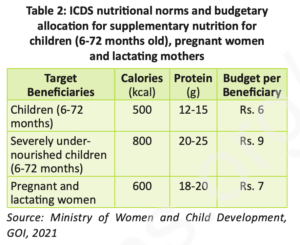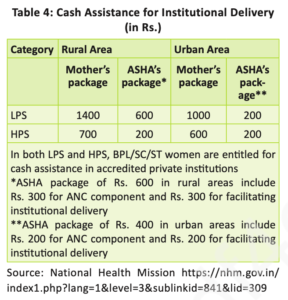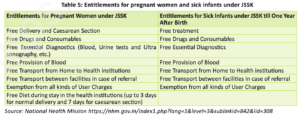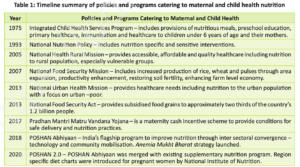ForumIAS announcing GS Foundation Program for UPSC CSE 2025-26 from 19 April. Click Here for more information.
Contents
- 1 Introduction
- 2 What is the meaning of Maternal and Child health?
- 3 What is the current status of Maternal and Child health?
- 4 Why is the need to focus on Maternal and Child health?
- 5 What are the factors that hinder Maternal and Child health?
- 6 What steps have been taken by the Government to promote Maternal and Child health?
- 7 What steps can be taken for further improving the status?
- 8 Conclusion
| For 7PM Editorial Archives click HERE → |
Introduction
Despite significant improvement over the last 2 decades, maternal and child health indicators continue to be poor in India. Maternal malnutrition has been linked to an increased risk of maternal morbidity, premature birth, and newborns that are too small for their gestational age. Because of the negative repercussions for both women and their children, poor maternal nutrition during and throughout pregnancy is a major public health concern. The Government has been running various initiatives for improving maternal and child health but much more needs to be done.
What is the meaning of Maternal and Child health?
According to the WHO, Maternal health refers to the health of women during pregnancy, childbirth and the postnatal period. It encompasses the health care dimensions of family planning, preconception, prenatal, and postnatal care in order to ensure a positive and fulfilling experience, in most cases, and reduce maternal morbidity and mortality, in other cases.
The WHO recommends that each stage (pregnancy and pre-natal care, childbirth and postnatal period) should be a positive experience, ensuring women and their babies reach their full potential for health and well-being.
The status of Maternal and Child Health is measured through indicators like Maternal Mortality Rate (MMR), Infant Mortality Rate (IMR), % of institutional deliveries, maternal nutrition like % pregnant women suffering from anaemia, child nutrition indicators like stunting, wasting etc.
What is the current status of Maternal and Child health?
National
As per National Family Health Survey 5 (NFHS-5) findings, only 11% of children aged 6 to 23 months had an adequate dietary intake. Overall, 67% children in the age group of 6 to 59 months; 53% of pregnant women (15-49 years) and 57% of adolescents (15-19 years) were anaemic.
While progress has been made, India is still falling short of meeting SDG 2.2 which calls for ‘ending all forms of malnutrition for children under the age of five’ by 2030. The percentage of stunted, wasted, underweight, and anemic children in India is 36%, 19%, 32%, and 67% respectively.
About one-quarter (23%) of preschool children had folate deficiency.
The % of institutional deliveries has improved significantly from 38.7% in NFHS-3 (2005) to 89% in NFHS-5.
Global
Maternal malnutrition is still a global problem, with 24% of mothers in South Asia having a low BMI (Body Mass Index). Furthermore, anemia affects 30% of reproductive-age women and 37% of pregnant women. Women’s overweight/obesity is a growing problem in most low-middle-income nations.
According to the WHO, 810 women die every day due to preventable causes related to pregnancy and childbirth. 94% of all maternal deaths occur in low and lower middle-income countries.
Why is the need to focus on Maternal and Child health?
Reduction in preventable deaths: The primary reason is to curtail the magnitude of preventable deaths in the country. A robust maternal health care system would definitely help in reducing the high number of maternal and infant mortality in many states. For instance, Assam witnessed the highest MMR of 215 in the country as per the Sample Registration System (SRS) report (2016-18).
Improved learning potential: Access to quality healthcare will improve the learning potential of children and reduce dropout rates at all levels of education. According to the the latest Unified District Information System for Education Plus (UDISE+ 2019-20) report nearly 30% of the students don’t transition from secondary to senior secondary level.
Decreasing Future Expenditure on Healthcare: Good nutrition and healthcare in early years can help an individual avoid many health problems in future. This reduces future healthcare expenditure for the masses and will enhance the productivity. Further, overall better healthcare levels will reduce the Government’s healthcare expenditure.
Global Commitments: It will help India fulfill its international commitments as well. Conventions like the UN declaration on Human Rights and targets like UN sustainable development goals place a duty for providing quality healthcare to mothers and children.
What are the factors that hinder Maternal and Child health?
Poverty: It reduces the capacity of families to spend on maternal and child health in a judicious way. The situation becomes even more grim considering high out-of-pocket expenditure in India which is around 60%.
Lack of Institutional Care: The penetration of hospitals and dedicated child delivery centers is scarce in rural regions. Further, there is an acute shortage of trained gynaecologists in these regions.
Gender Inequality: Women in rural areas still lack access to education. Child marriage is still rampant in many parts of India leading to teenage pregnancies that hinder maternal and child health.
Informal Nature of Economy: More than 90% of India’s economy is informal in nature under which it is very easy to hire and fire an individual. Considering this, women engaged in the informal economy are unable to take a requisite number of child care leaves during and after pregnancy.
Lack of Food and Nutritional Security: According to National Nutrition Monitoring Bureau (NNMB) surveys in 10 Indian states, cereals and millets make up the majority of rural diets. However, only approximately half of pregnant women get enough protein and calories.
The NNMB also revealed that most pregnant women’s iron, vitamin A and C, and folic acid consumption were less than half of what was advised.
Son Meta Preference: Son meta preference refers to the desire of having a male child and is widely prevalent. This subjects women to repeated pregnancies even at a higher age that deteriorates the health of mother and the child.
What steps have been taken by the Government to promote Maternal and Child health?
POSHAN Abhiyan (National Nutrition Mission): It aims to enhance maternal nutrition by employing technology, behavior change communication, community engagement, and cross-sectoral convergence.
In 2020, POSHAN Abhiyaan was merged with the existing supplementary nutrition program. Region specific diet charts were introduced for pregnant women by the National Institute of Nutrition.
Integrated Child Development Services (ICDS): It includes provisions of nutritious meals, preschool education, primary healthcare, immunization and healthcare to children under 6 years of age and their mothers.
Source: Kurukshetra
Take-Home Rations (THR) comprising micronutrient fortified blended food and/ or energy dense food are supplied under the scheme.
The complementary nature of the cereal-pulse combination for improving the protein quality of the meal is the guiding principle for deciding the combination. In some parts of the country milk powder (skim/whole) and eggs are also provided.
Pradhan Mantri Matru Vandana Yojana (PMMVY): It is a maternity cash incentive scheme to provide conditions for safe delivery and nutrition practices. It is implemented in all the districts of the country in accordance with the provision of the National Food Security Act, 2013.
Under the Scheme, Pregnant Women and Lactating Mothers (PW&LM) receive a direct cash benefit transfer of Rs. 5,000 in three installments.
Janani Suraksha Yojana (JSY): The National Rural Health Mission’s Janani Suraksha Yojana (JSY) aims to reduce maternal and infant mortality by promoting institutional delivery among pregnant women. Under the scheme, eligible pregnant women are entitled to cash assistance of Rs. 1400 (rural) and Rs. 1000 (urban) in low performing states.
The programme also offers performance-based incentives to ASHA (Accredited Social Health Activist) who promote institutional delivery among pregnant women.
Source: Kurukshetra
Janani-Shishu Suraksha Karyakram (JSSK): It was established with the goal of eliminating out-of-pocket payments for pregnant women and unwell newborns seeking treatment at a public health facility. Every year, more than 1 crore pregnant women in both urban and rural areas use public health facilities.
Source: Kurukshetra
Rashtriya Bal Swasthya Karyakram (RBSK): It is a significant effort aimed at early detection and intervention for children aged newborn to 18 years. It covers the four ‘D’s: Birth Defects, Deficiencies, Diseases, and Developmental Delays including Disability.
Once the child has been examined and referred, the necessary intervention is provided to the family at no cost.
Source: Kurukshetra
What steps can be taken for further improving the status?
First, there is a need to raise awareness in masses about the multi-pronged benefits of quality maternal and child health care. For this, a Jan Andlolan component must be inculcated in all key initiatives.
Second, the government should come up with innovative ideas for regions where more action is needed. For instance, the government can take help of a regional sports person to promote exclusive breastfeeding for 6 months.
Third, learning from global examples can also be taken for improving healthcare. For instance, Mexico’s increased taxation on sugar sweetened beverages led to 5.5% drop in consumption in the first year, followed by a 9.7% decline in the second year.
These reductions positively impacted health outcomes (especially obesity and type 2 diabetes) and reduced healthcare expenses in Mexico.
Fourth, Public Accountability tools like Social Audit, participatory budgeting etc. should be strengthened in states so that effective implementation of healthcare schemes can occur.
Fifth, the government should provide more funds to vulnerable states like Assam, U.P, Bihar etc.. for improving the overall condition of maternal health.
Conclusion
Good Health is sine qua non for performing all the other activities in life. India must take robust measures to ensure that all mothers and their children are able to get access to affordable and quality healthcare across the nation. Future discourse must be carried on keeping in mind the popular saying of ‘Health is the real wealth’.








